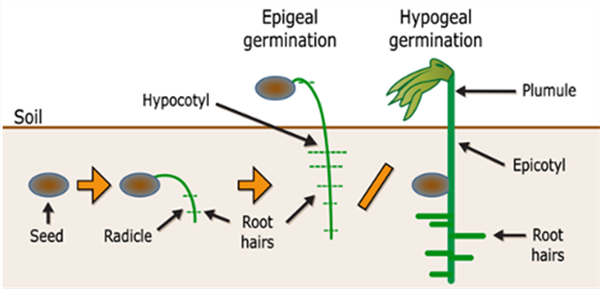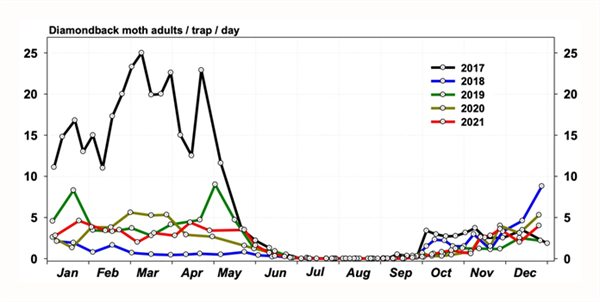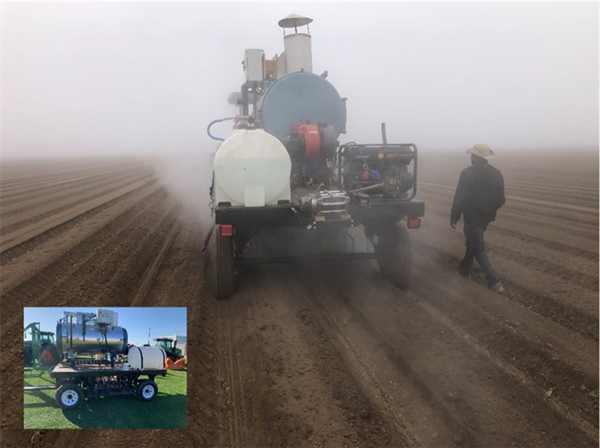Sep 7, 2022
Germination and Seedling Development
With the planting of every crop there is a time of anticipation as we wait and watch for germination, seedling emergence, and the development of a good stand of plants to start the crop season. Successful seedling establishment is the first critical step for the production of any crop and it determines the foundation for either the success or failure of the future harvest. So, it is worthy to review some fundamentals associated with the process of seed germination and seedling establishment.
Most crops produced worldwide begin with the planting of a seed and management to sufficiently establish a satisfactory population of new plants in the field. Good seed germination and establishment is an essential and critical first step in the production of a good crop. Most crop seeds are desiccation tolerant while dormant and as a result can be stored and transported while preserving their ability to grow. Seeds carry the full genetic complement of the crop and serve as the genetic delivery mechanism for a crop production system. Farmers require seeds that will provide for a reliable and successful establishment of a crop.
An interesting aspect of seed germination and establishment is that seeds generally represent the condition of highest degree of resistance to extreme environmental conditions, while seedlings are most sucseptible. Viable seeds are dormant living organisms that contain living, embryonic tissue that is essential for germination. All fully developed seeds contain an embryo and a reserve supply of carbohydrates and nutrients to carryout germination and establishment and the full “package” is contained within a seed coat.
Seeds are stimulated to “wake up” and start the germination process when soil moisture and temperature conditions are appropriate for them to grow. The three cardinal points of vital activity for germination are: 1) a minimum temperature, below which no activity occurs, 2) an optimum temperature at which the highest germination occurs, and 3) a maximum temperature above which no germination takes place.
All seeds need correct moisture and temperature environments (Table 1) to initiate internal biochemical processes associated with the initation of germination. Soil-water content generally needs to be at least approximately 50–75% of field capacity. A fine-textured seedbed and good seed-to-soil contact are very imporant for optimal germination.
Good soil aeration that facilites good gas exchange between the germinating embryo and the soil environment is very important. Seeds respire just like any other living organism. Germinating seeds need oxygen and they produce carbon dioxide (CO2). The CO2 needs to be able to diffuse away from the seed and if the soil is compacted or saturated, aeration is inhibited and the CO2 respiration will not be able to dissipate to the atmosphere, and as a result the seeds can suffocate in the soil.
There are three major steps in the initial process of seed germination. These include: 1) imbition, 2) interim or lag phase, and 3) radicle and root emergence.
In the imbibition process seeds rapidly absorb water through the hilum of the seed and the seed coat will then swell and soften.
In the interim or lag phase the seeds internal biochemical and physiological system goes into action. Cells begin respire with this physiological activity and the seed begins to metaboloize its storehouse of energy and nutrient reserves to manufacture proteins other essential metabolites.
The radicle is the very first element of the rooting system that is developed and it is the first thing to emerge from the seed. In the field, we often refer to the radicle as the first “stinger” root that is developed. In the field, it is good to dig into the seedbed and examine early seedling development and look for healthy radicles, with clean, white, and turgid tissue.
In the process of radicle and root emergence, the cells of these tissues start to elongate and divide, the seed continues to imbibe water, and then it begins to extend out and away from the seed into the soil. These early root tissues, specifically the fresh root hairs become quickly capable of water and nutrient uptake. The young root tissues are very sensitive to the soil environment, particularly the soil solution. It is in this stage for example when seedlings are often very sensitive to salinity in the soil solution and disease infections.
When the radicle begins absorbing water from the soil solution, the seedling gains the capacity to extend a shoot from the seed towards the soil surface for emergence. In dicotyledonous (dicot) plants (generally referred to as broadleaf plants) the two seed leaves are extended above the soil for emergence. The section below the shoot and the cotyledons is referred to as the “hypocotyl” and the section of the shoot above the cotyledons is the “epicotyl”, Figure 1.
There are two basic methods of emergence for plants. In most dicot plants, a hook is formed in the section of shoot below the cotyledons which serves to pull the cotyledons and the growing point of the new plant up through the soil. Upon the reaching the soil surface, the hook will straighten and pull the cotyledons (seed leaves) and shoot tip into the air. For the farmer or agronomist in the field, that is a good sight to see. This method of emergence is called “epigeous or epigeal germination”. Examples of epigeal germination are cotton, sunflower, castor, and bean (common bean), Figure 1.
In other plants a process of “hypogeous or hypogeal germination” takes place. In hypogeous germination, the hypocotyl remains short and the cotyledons do not emerge from the seed and remain underground. Instead, the radicle and epicotyl axis will elongate and extend out of the seed coat. The epicotyl grows up through the soil and emerges above the soil surface and forms a epicotyl or “plumule” for the first leaf, Figure 2a and b.
All monocotyledons plants such as maize, rice, wheat, and coconut show hypogeal germination. It is also interesting to note that some dicot plants show hypogeal germination such as groundnut, gram, and peas.
In general, plants with epigeal germination, most dicot or broadleaf plants, are more sensitive to soil crusting and environmental inhibitions to emergence. So it is good to know what type of germination and emergence characteristics are natural for a given crop species and to track seedling development in the field accordingly.
As we begin any new crop season in the field and plant the seeds, it is good to review the basic process of seed germination and establishment. We can easily take all of this for granted until something goes wrong and we have problems in the field with emergence. After planting, it is good to monitor in-field seedling conditions and progression of growth and development, both above and below ground, and provide good management that supports the young plants as they get established and start their growing cycle.
Table 1. Soil temperature (oF) for crop germination. Adapted from Kemble and Musgrove (2006).
|
Crop
|
Minimum
oF
|
Optimal Range
oF
|
Optimum
oF
|
Maximum
oF
|
|
Beet
|
40
|
50–85
|
85
|
85
|
|
Cabbage
|
40
|
45–95
|
85
|
100
|
|
Cauliflower
|
40
|
45–85
|
80
|
100
|
|
Celery
|
40
|
60–70
|
70
|
85
|
|
Chard
|
40
|
50–85
|
85
|
95
|
|
Cucumber
|
60
|
60–95
|
95
|
105
|
|
Eggplant
|
60
|
75–90
|
85
|
95
|
|
Lettuce
|
35
|
40–80
|
75
|
85
|
|
Melons
|
60
|
75–95
|
90
|
100
|
|
Onion
|
35
|
50–95
|
75
|
95
|
|
Parsley
|
40
|
50–85
|
75
|
90
|
|
Pepper
|
60
|
65–95
|
85
|
95
|
|
Pumpkin
|
60
|
70–90
|
90
|
100
|
|
Spinach
|
35
|
45–75
|
70
|
85
|
|
Squash
|
60
|
70–95
|
95
|
100
|
|
Tomato
|
50
|
70–95
|
85
|
95
|

Figure 1. Seed germination and plant establishment for a plant with epigeal
germination and emergence, which is common with most dicot or broadleaf
plants.

Figure 2a. Examples and comparison of epigeal and hypogeal germination.

Figure 2b. Examples and comparison of epigeal and hypogeal germination.
References
Kemble, J., and M. Musgrove. 2006. Soil Temperature Conditions for Vegetable Seed Germination. Alabama Cooperative Extension.
To contact Jeff Silvertooth go to:
silver@ag.arizona.edu
 To contact John Palumbo go to: jpalumbo@ag.Arizona.edu
To contact John Palumbo go to: jpalumbo@ag.Arizona.edu














